Maximizing Wood Utilization: Egoin's Next-Generation Cross Laminated Timber Production
Complete
Solution
from System TM and Kallesoe Machinery
Egoin Wood Group
For its state-of-the-art facility in Legutio, Spain, the Basque company chose a comprehensive solution by System TM and Kallesoe Machinery.

From Forest to Finish
Siskiyou Forest Products
The Northern California company is upgrading its production by replacing an older finger-jointing line with an industry leading System TM optimizing finger-jointing line.
Readthefullstoryonpage2
Boosting Wood Utilization
Cypress Sunadaya
With an impressive 132 years in business, this Japanese sawmill is a company with a long history. With their new Opti-Kap 3002 optimizing cross-cut line, they are poised for a bright future.
Readthefullstoryonpage3




Preformance Update
Jeld-Wen
A brand new finger-jointing line, one of many the Jeld-Wen Group has purchased from System TM over the years, was installed where it all began, in Kalamath Falls, Oregon.
Readthefullstoryonpage6
Cutting Edge
Algonquin
With their new System TM line, including planer infeed, rip scanner, automatic edge removal after the rip saw, cross-cut optimization in any width, cross-cutting and sorting, the Canadians are ready to make their mark.
Readthefullstoryonpage7
no. 1 - 2024 www.systemtm.com NEWS Member of the HOMAG Group optimization of staff and wood resources
Read the fullstory on page 4-5

>> Dant Enderson, Plant Manager at Siskiyou Forest Products:
‘‘Our hope is to improve manufacturing through speed and efficiency in addition to saving labor.”
From Forest to Finish: Siskiyou Increases Productivity while Prioritizing Sustainability with System TM Finger-Jointing Line
The Northern California high quality, grain specific, kiln dried lumber experts are upgrading their production by replacing an older finger-jointing line with a state-of-the-art System TM optimizing finger-jointing line.
ByAislinnEsterle
Returning System TM customer Siskiyou
Forest Products acquired an optimizing crosscut line including two Opti-Kap 5103 crosscut saws and a MiCROTEC Goldeneye quality scanner in 2017. Now they have added an Opti-Joint H-200 horizontal finger-jointing line to complete their set of System TM equipment. This further optimizes their production and allows them to take full advantage of their optimizing equipment from System TM.
Space to grow
Located at the foot of the Siskiyou Mountain Range and on the doorstep of the Klamath National Forest, Siskiyou's lumber distribution center is in the heartland of cedar and redwood growing from central California to the southernmost tip of Alaska.
By eliminating their old finger-jointing line and replacing it with a cutting-edge horizontal finger-jointing line, model Opti-Joint H-200, including an automatic stacking system, model Opti-Stack 9000, Siskiyou is going the extra mile toward more sustainable production and better overall wood utilization. “Our hope is to improve manufacturing through speed and efficiency in addition to saving labor,” says Dant Enderson, Plant Manager at Siskiyou Forest Products.
Modular design
>> This System TM solution consists of the following:
• Horizontal finger-jointer, Opti-Joint H-200
• Automated stacking system, Opti-Stack 9000
Siskiyou is committed to manufacturing products of the highest quality and craftsmanship by utilizing top of the line equipment such as System TM machinery. This commitment is backed by decades of experience in the sawmill and lumber business. Their new optimizing finger-jointing line will be used to produce finger-jointed redwood and incense cedar components, providing room to grow and expand their production.
Conservation through efficiency
Sustainable forestry and reforestation, as well as reducing waste in their production by using sawdust as biomass fuel or improving the use of their raw lumber, are some of Siskiyou's guiding principles. To protect forests and the environment, and to manufacture products with integrity, they emphasize recycling in their production. For example, by finger-jointing perfectly usable, but too short or too narrow, lumber and re-manufacturing it into pieces with precision joints to create a usable finished product. This is an effective way to conserve through efficiency.
“All of System TM’s lines are modular build. This means that no line is the same and it always depends on the specific wants and needs of the single customer,” says Michael Brandt, System TM Area Sales Manager for the United States. In this case, the Opti-Joint H-200 horizontal finger-jointing line is a semiautomatic setup. This means that the fingerjointing blocks, coming from the existing System TM cross-cut line, are automatically transferred from sorting conveyors to the lug loader, but the placement of the blocks before the lug loader has to be done manually. The lug loader feeds the blocks one at a time into the lug chain of the finger-jointing machine. They are measured and optimally positioned before entering each shaper station to ensure high precision as they pass through the shaper. After the finger profile has been created, glue is applied to one side of the blocks, while the correct glue application is checked immediately afterwards by detecting the luminescent liquid added to the adhesive. After the glue is applied, the blocks are aligned
lengthwise in the pre-alignment station and transferred to the pre-press and press station.
Flexible fixed lengths
After the press, the finger-jointed workpieces are cut into fixed length boards by a split saw positioned to cut to the correct length. The saw unit can be automatically adjusted lengthwise from the control panel, providing additional production flexibility. Once the workpieces have been pressed and cut to the desired length, the Opti-Stack 9000 automatic stacking system stacks them side by side to create packs. When the packs are finished, they travel on a pack chain carrier where an operator can strap them while the next packs are stacked.
A
win-win situation
Siskiyou Forest Products is committed to providing a better product at a fair price, and with their System TM finger-jointing line they are able to improve the quality of their finished product and achieve a better market value. By choosing System TM over the competition, Siskiyou is capitalizing on their existing line and can achieve even better utilization of their wood and staff resources. On the one hand, the new line fits in perfectly with the existing line, and on the other hand, the operators are used to working with System TM machines. Thus, training time can be kept to a minimum. “We have noticed improved production capacity and overall appreciation for System TM throughout this process,” says Darren Duchi at Siskiyou Forest Products.

2
Overview: Production: Windows & doors Wood species: Softwood Number of operators: Overview: Production: Components Wood species: Softwood Number of operators:
OPTI-JOINT H-200 Horizontal finger-jointing machine OPTI-STACK 9000 Automated stacking system PRESS UNIT
SiskiyouForestProducts manufactures
cedar
and redwood exterior siding. The picture shows an example of a cedar sided home.
Cypress Sunadaya Boosts Wood Utilization with System TM’s Cross-Cut Line
With an impressive 132 years in business, this Japanese sawmill is a company with a long history. With their new Opti-Kap 3002 optimizing cross-cut line, they are poised for a bright future.
ByAislinnEsterle
At the beginning of each project, System TM engages in a dialogue with the customer to define the framework in terms of production capacity, available space, and other specific requirements such as labor availability and desired wood utilization. Based on their needs, Cypress Sunadaya opted for a semiautomated line in which workpieces are marked and manually fed into the line by up to four operators. The workpieces are then cut to size and automatically sorted.
From salt to sawmill
Cypress Sunadaya Co.,Ltd. is one of the largest producers of cypress and laminated lumber in Japan. It was founded in the 25th year of the Meiji Era (1892), when Sunada Kaji established the "Sunadaya Lumber Store" as a lumber merchant. However, the company's history goes back even further. In the first year of Genroku (1688), the first Sunadaya Yozaemon started a salt pan business under the trade name "Sunadaya". Much has changed since their first steps into the wood industry, manufacturing the "Shiokuwa" salt pan tool and using only cherrywood, which was the material for salt pans then. Today, they are one of the two leading CLT manufacturers in Japan and a key player in the timber construction industry.
Custom automatization
Douglas fir, Japanese cedar, and cypress wood are the main species used in this particular System TM solution, producing cross-cut components for Cypress Sunadaya’s CLT and GLT production. It was flexibly set-up according to our customer’s needs, like all our solutions that can be optimized
up to a degree, where only one operator is all that is needed to keep production flowing seamlessly. In this optimizing cross-cut solution for Cypress Sunadaya, the faults are marked by hand rather than automatically recognized by a quality scanner.
Visual quality assessment
The line starts with packs of raw material being delivered to the line via forklift and positioned in front of the marking stations. Four operators will manually transfer workpieces into the marking station and mark them with luminescent crayon according to visible defects and quality. The marking station includes a mirror and light setup, to make it possible to examine the bottom side of the workpieces without turning them. When the marking process is completed, the operator manually activates the tilting function of the undriven roller conveyor to deliver the marked workpiece into a feeding chain conveyor.
Cut to precision
From the feeding chain conveyor, the workpieces reach a single-piece feeding station, that will feed one workpiece at the time into the measuring system of the cross-cut saw. The measuring system measures both, the length as well as the position of the crayon marks indicating quality and defects of the workpieces. The information is consequently transferred to the saw computer, which optimizes the workpieces according to the information from the measuring station and the cutting lists generated by the customer. After optimization, the workpieces will be transferred into the optimizing cross-cut saw
model Opti-Kap 3002 and cut accordingly. Afterwards, they are split into short waste, long waste, finger-joint and fix-length components. The short waste pieces are already rejected inside the saw unit, whereas the rest is automatically sorted into multiple destinations on the sorting belt.
Improving utilization
Being one of the biggest producers of domestic lumber and CLT for structural use, Cypress Sunadaya plays an important role in promoting the circular utilization of forests. They are already a highly energy efficient manufacturer by producing everything from logs to the finished product at one site and keeping transportation distances to a minimum. Through including a System TM Opti-Kap 3002 cross-cut saw they will be capable of improving utilization in the production of workpieces from different wood species, lengths and thicknesses. Cutting to size according to different qualities instead of accepting limitations regarding product quality. Moreover, by choosing an Opti-Kap, they unlocked a wide range of material handling solutions, all depending on production needs and space requirements, should they wish to upgrade their line in the future.

>> This System TM solution consists of the following:
• Marking stations
• Feeding chain conveyor
• Measuring system
• Optimizing cross-cut saw, Opti-Kap 3002
• Sorting system

Overview:
Production: Windows & doors
Overview: Production: Components
Wood species: Softwood
Wood species: Softwood
Number of operators:
Number of operators:
3
The main wood species used by Sunadaya is Japanese cypress.
OPTI-KAP 3002 Optimizing cross-cut saw
MARKING STATION MEASURING SYSTEM CHAIN CONVEYOR
SORTING SYSTEM
The production facility Egoin Albertia covers an area of 28,500 m2 and has a production capacity of up to 42,000 m3 per year.
 >> Unai Agirre, Managing Director at Egoin Wood Group:
>> Unai Agirre, Managing Director at Egoin Wood Group:
‘‘With the opening of Egoin Albertia, we are taking a decisive step towards consolidating our position in the wood construction sector, with a clear focus on the industrialisation and digitalisation of our processes.”
Maximizing Wood Utilization: Complete Solution for Egoin's Cross Laminated Timber Production
The Basque company chose a complete solution from System TM and Kallesoe Machinery System TM's contribution includes a separate grading line as well as a finger-jointing line
ByAislinnEsterle
Over the last 15 years, the Egoin Wood Group has built a strong reputation in the structural timber industry, producing Cross Laminated Timber (CLT) and Glue Laminated Timber (GLT). With the new plant, they are doubling their capacity with a complete solution from HOMAG Group sister companies System TM and Kallesoe Machinery. "With the opening of Egoin Albertia, we are taking a decisive step towards consolidating our position in the wood construction sector, with a clear focus on the industrialisation and digitalisation of our processes," says Unai Agirre, Managing Director. The Albertia plant in Legutio (Araba, Basque Country) is now the largest CLT plant in Southern Europe, producing structural timber components for the construction industry in radiata pine.
Seeds of success
The Egoin Wood Group has grown to become a market leader in advanced engineered wood technologies in Southern Europe, expanding into Continental Europe, the UK and beyond, since the seeds were planted as a family business in the 90's. They now have over 30 years of experience in engineered wood solutions, from design and engineering to delivery and installation.
In 2023, Hasslacher Norica, a market-leading Austrian manufacturer of GLT and CLT, acquired a minority stake in Egoin and entered into a strategic collaboration that promises to bring innovation in high-volume production of mass timber elements, tall building construction and the opportunity to explore new markets.
Pioneering with KM Zero pine
Egoin is a pioneer in the CLT/GLT industry with extensive experience in both the private and public sectors on projects ranging from farmhouse renovations to multi-story office buildings. They are also at the forefront of sustainable production, using a holistic approach from sustainable forestry to the finished timber structure.


Since 2008, Egoin has adopted a KM Zero approach, where all wood fiber must be sourced within a 100 km radius of their mills. This strategy is directly aimed at reducing CO2 emissions in the construction sector, thus increasing the value of local forestry, especially radiata pine and other conifers sourced from sustainably managed forests in the Basque Country.
The System TM solution, which incorporates some of our most advanced technologies, delivered to Legutio's outstanding CLT production facility, will help improve the utilization of valuable local raw wood.
Maximum use of wood and equipment
"Flexibility was an important factor in this project," says System TM Area Sales Manager Peter Simonsen, adding that “the separate System TM Opti-Kap grading line can be used to produce CLT components, panels and beams”. It can be used in a completely independent way to grade and cut different qualities of wood, which can then be fed into a number of different production lines.
In addition, the Opti-Joint V-L vertical finger-jointing line, which is integrated seamlessly with Kallesoe's HF (high frequency) press line, can be used to produce lamellas for roofing and roof components, GLT, CLT and timber framing. On the other hand, the workpieces can be fed to an Opti-Stack 9000 stacking system. This gives Egoin the flexibility to use its graded and finger-jointed lengths of consistent quality in its other CLT
production line, guaranteeing maximum use of equipment and raw material. All this allows Egoin to work according to its principles and to make the best use of its precious and sustainable resources.
Cutting-edge quality control
The System TM Opti-Kap Solution produces finger-joint components for CLT and glue beam production. The focus is on strength grading to achieve the required strength and quality. It consists of an OptiFeed 6000 Vack infeed, an Opti-Kap 3003 cross-cut saw and three Opti-Stack 3000 Vack stackers. The line starts with a pack roller conveyor that processes three packs at a time. When one pack is unloaded, the pack roller signals the next pack to enter the line. The layers are separated by a tilt hoist, with drying sticks collected separately. The workpieces are then separated by the unscrambler and transported to the feeding
conveyor, which feeds them one at a time into the stud carrier
Best-in-class grading technology
To achieve the best possible results in terms of quality and strength grading, the line includes a number of state-of-theart measuring and scanning devices from MiCROTEC, including Goldeneye, Viscan, Warpscan and M3 Scan transversal. For optimal measurement and defect detection, workpieces are trimmed to obtain a clean cut before passing through a series of measurements. MiCROTEC's Viscan strength grader identifies the MOE (Modulus of Elasticity) of the workpiece, then the Warpscan determines if it needs to be rotated before entering the moulder. The M3 Scan measures moisture. Workpieces with too much warp or too much moisture can be rejected via a reject gate. A Fifo Marking inkline is mounted to keep track of all work-

OPTI-FEED 3000 VACK Automated feeding system
MATERIAL HANDLING Automated equipment for efficient flow of material
4
OPTI-KAP 3003 Optimizing cross-cut
saw
MOULDER
SCANNER
MICROTEC WARPSCAN FIFO MARKING INKLINE MICROTEC
SCAN Moisture measurement MICROTEC VISCAN OPTI-JOINT
MICROTEC GOLDENEYE
Detection of defects and quality before cross-cutting
M3
V-L Vertical finger-jointing machine
Egoin's Next-Generation Production
Machinery for its state-of-the-art plant in Legutio, Spain. line for long workpieces to maximize wood utilization.
pieces by spraying a mark that triggers another check when it later passes through the Goldeneye scanner.
Precision cutting
The workpieces then move to a buffer conveyor before entering a moulding machine one at a time. They then proceed to the Goldeneye multi-sensor quality scanner, a best-in-class solution for strength grading at high production speeds. The workpiece data is sent to the Opti-Kap 3003 crosscut saw, which cuts them according to the defect detection and optimization data from the scanner. Once the workpieces are cut, they are transferred to the sorting conveyor. Short offcuts are removed inside the saw unit, while long offcuts are kicked out by the first kicker on the sorting belt. The following two kickers are dedicated to different fingerjoint cut lengths. All remaining workpieces of different grades and lengths are transported to three Opti-Stack 3000 Vack stacking machines, which automatically stack them. Once a pack is full, it is indexed forward on a pack outfeed chain and can be picked up by a forklift operator.
Consistent quality
The graded and optimized parts from the Opti-Kap line can now flexibly enter different production cycles within the Egoin production infrastructure. A logical step is their new System TM Opti-Joint solution, designed to obtain uniform parts of a given quality for CLT production. It comprises an Opti-Joint V-L vertical finger-jointing line with an OptiFeed 3000 Vack automatic feeding system. High capacity, durability and precision are three key principles of this System TM Opti-Joint finger-jointing line, which starts with pre-sorted packs of different qualities placed on the two pack infeed chains. A scissor lift raises the packs to a uniform height for the Opti-Feed 3000 Vack, which then picks up one layer at a time and places it on the infeed conveyor. The workpieces then enter the batch building system and are automatically transferred to the two shapers of the Opti-Joint V-L, which create the finger profile required for the jointing process. After glue and hardener are applied, the workpieces are transferred to the alignment station to ensure precise positioning. Thereafter, the workpieces enter a continuous press unit where they are pressed together to create a finger-jointed workpiece. Finally, they are transferred to a storage system,
marking the beginning of Kallesoe's HF press line in this production facility.
Complete solution for success
Using HOMAG Group members System TM and Kallesoe as partners for their project ensured a smooth project management process and minimized the coordination effort between all partners. "As long-standing collaborators, we have enough experience of working together to ensure a smooth process throughout," says Peter Simonsen, adding that "by involving trusted partners such as MiCROTEC, we are able to deliver a complete solution". Furthermore, "the open and accessible design of our machines, as well as the use of many standard components, gives our customers peace of mind," explains Peter Simonsen, pointing out that it also saves time and money on maintenance. "Within this new line, it is worth mentioning the new high frequency press with a production capacity of more than 42,000 m3 per year. This technological advance will allow us to offer products of the highest quality and meet market demands in an efficient and sustainable manner, taking another step towards excellence in production and innovation at CLT," adds Egoin Wood Group's Managing Director Unai Agirre.

>> This System TM solution consists of the following:
• Automated feeding system, Opti-Feed 6000 Vack
• MiCROTEC Warpscan
• MiCROTEC M3 Scan
• MiCROTEC Viscan
• Fifo Marking inkline
• Moulder
• MiCROTEC Goldeneye scanner
• Optimizing cross-cut saw, Opti-Kap 3003
• Sorting system
• Automated stacking systems, Opti-Stack 3000 Vack
• Material handling
• Automated feeding system, Opti-Feed 3000 Vack
• Vertical finger-jointer, Opti-Joint V-L with continuous press unit


Overview:
Overview:
Production: Windows & doors
Production: Components
Wood species: Softwood
Wood species: Softwood
Number of operators:
Number of operators:
5
Utilization:
OPTI-STACK 3000 VACK Automated stacking system KALLESOE HF PRESS LINE OPTI-FEED 6000 VACK Automated feeding system CONTINUOUS PRESS UNIT SORTING SYSTEM
Egoin Wood Group celebrated the official opening of the new Albertia plant in Legutio Araba, Basque Country on March 6th, 2024.
As one of the biggest producers of windows and doors worldwide, Jeld-Wen operates in 16 facilities in North America and Europe, employing approx. 18,000 people.
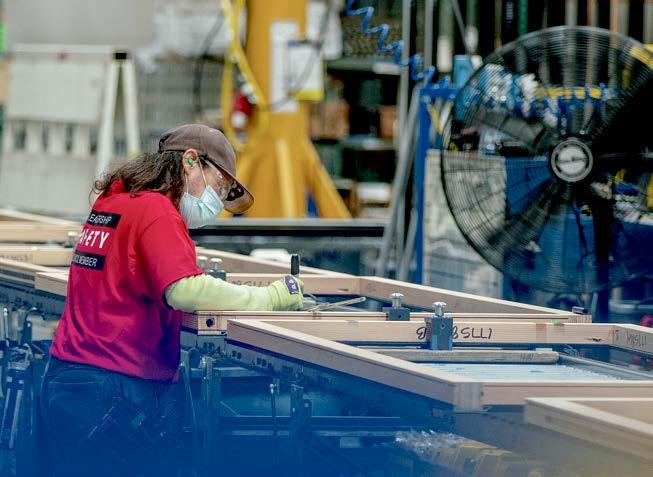

Jeld-Wen’s Historic Factory Gets Performance Update with Brand New Finger-Jointing Line
This new finger-jointing line, one of several the Jeld-Wen Group has purchased from System TM over the years, was installed where it all began, in Kalamath Falls, Oregon. It includes an Opti-Feed spin-feeder for automatic workpiece alignment and an optimizing horizontal finger-jointing system Opti-Joint H-200.
ByAislinnEsterle
System TM is pleased to once again supply a company that is as concerned about utilizing every bit of raw material as System TM is about designing equipment optimized to maximize yield while minimizing waste. With their new line in Klamath Falls, Jeld-Wen manufactures finger-jointed components for interior and exterior softwood and hardwood doors and windows.
Pursuing the same goal
This System TM solution consists of the following:
• Automatic workpiece alignment, Opti-Feed spin-feeder
• Horizontal finger-jointer, Opti-Joint H-200
Founded in 1960 in Oregon, the company is now headquartered in North Carolina and operates in more than 16 countries in North America and Europe. Jeld-Wen is one of the largest manufacturers of windows and doors in the world. Its durable, energy-efficient doors, windows and related building products are manufactured, showcased, and distributed by approximately 18,000 employees around the globe. The secret of Jeld-Wen's superior windows and doors lies partly in an exclusive manufacturing process that specially prepares the raw material. On the other hand, the company has always been very resourceful and makes good use of every piece of wood that comes through its doors. This philosophy is more relevant today than ever before and
fits perfectly with System TM's unwavering commitment to developing equipment that optimizes staff and wood resources.
A strong partnership for improvement
For many years, System TM has had the privilege of being a system solutions partner to the global Jeld-Wen family, supplying them with equipment that helps them improve their overall wood utilization. The new Opti-Joint H-200 horizontal finger-jointing line will ensure that this improvement continues. The line starts with a spin-feeder, where the unsorted workpieces enter the line and are aligned by centrifugal force. They are then transported to the lug-chain of the finger-jointing machine before they enter the shaper stations. Sensors measure the squareness of the lug ends and detect misalignment, which is corrected by repositioning the blocks, optimizing the amount of material to be ground off.
Flexibility through two-channel system
The workpieces then reach the shaper station and pass alternately through the two shapers, which score the finger profiles, before the glue is applied to one side of the blocks. A luminescent liquid added to the glue helps to ensure that only workpieces with
properly applied glue enter the pre-alignment station and subsequently the pre-press station of the Opti-Joint H-200 finger-jointer. There, all finger joints are pre-pressed before they enter the press.
The press station itself is a two-channel system with cross-cut blade and hydraulic end pressing. This means that the pre-pressed parts are cut to a uniform length before entering the press. It is possible to press either one long piece or several smaller pieces at the same time. All while meeting production requirements. This not only saves material, but also optimizes its use.
Growth through optimization
The decision to keep optimizing production processes by investing in new machinery is the smart and sustainable way to move forward for any multi-national company like Jeld-Wen. With extensive experience in staff and wood optimization, System TM has proven to be a reliable partner in doing just that. "It speaks volumes that Jeld-Wen has chosen to buy from System TM yet again.” says Area Sales Manager for the United States Michael Brand and adds: “In fact, their next project is already scheduled for delivery in 2024.” Performance improvements, flexibility and reliability are three of the key elements of this system solution. The latter two also apply to System TM's project management. To achieve the required performance of this and all of our developed lines, we strive to be the reliable partner our customers deserve, while remaining as flexible as possible in the planning process.
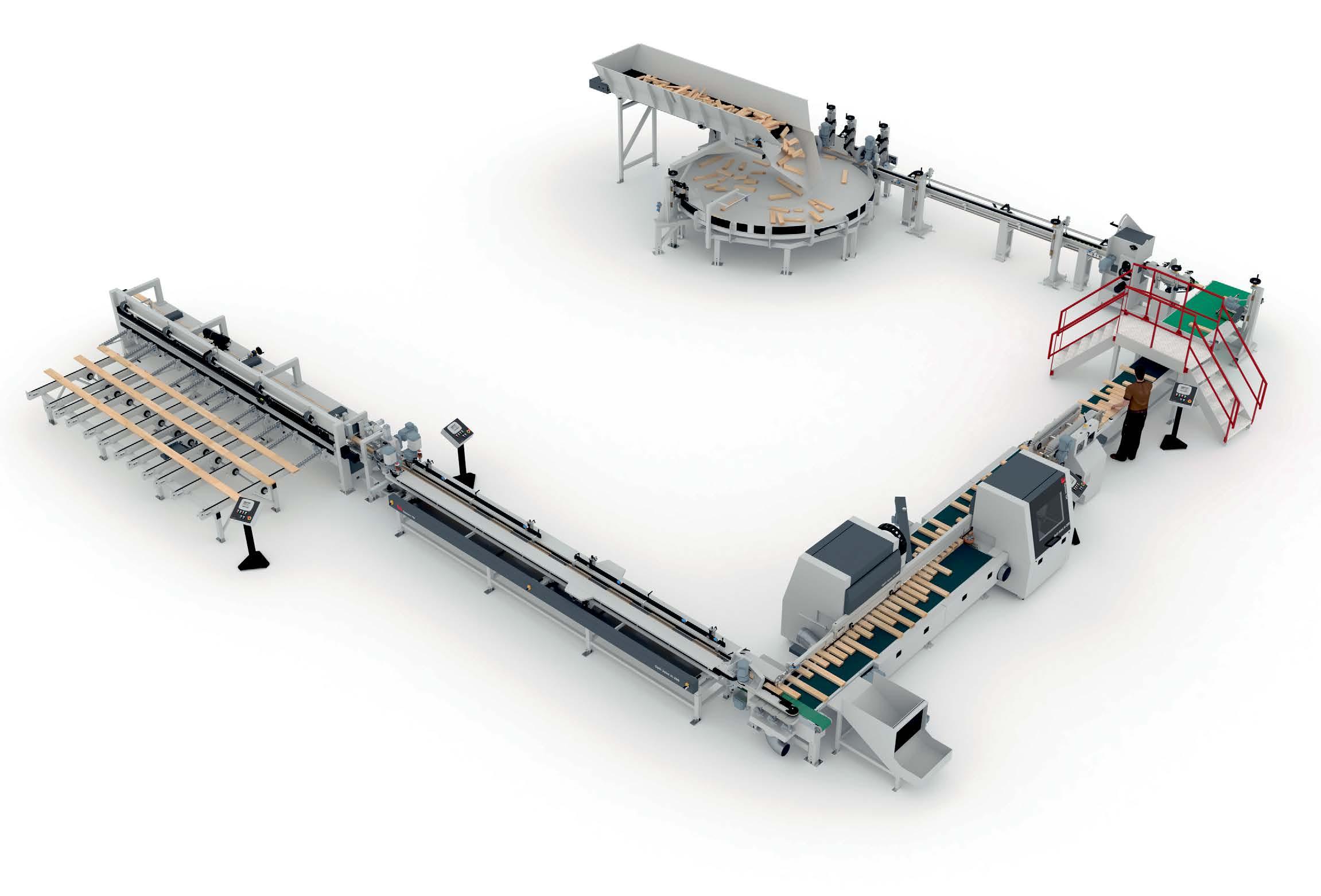
Overview:
Overview:
Production: Windows & doors
Production: Windows & Doors
Wood species: Softwood
Wood species: Softwood
Number of operators:
Number of operators:
>> 6
PRESS UNIT OPTI-JOINT H-200 Horizontal finger-jointing machine
OPTI-FEED SPIN-FEEDER Automatic workpiece alignment
On the Cutting Edge: New Optimizing Rip and Cross-Cut Line for Algonquin
With their new comprehensive System TM line, including planer infeed, rip scanner, automatic edge removal after the rip saw, cross-cut optimization in any width, cross-cutting and sorting, the Canadians are ready to make their mark.
ByAislinnEsterle
When it came time to invest in new optimization technology, Algonquin did not hesitate: "Our collective experience, coupled with our professionalism, gave them the confidence to entrust us with this project," says Jean-Luc Croteau, Area Sales Manager at System TM. "Given their previous experience with System TM, it was clear from the start that we were the best choice to fit the new project into the available space."
Our expertise for your excellence With over 60 years of experience in the secondary forest products industry, Moulures Algonquin Mouldings is a leading manufacturer of mouldings and wood components serving customers in North America, Europe and Asia. At their manufacturing facility in Mirabel, Quebec, Canada, they produce customizable, superior wood solutions designed to exceed their customers' expectations. These include stair and staircase components, cabinet and kitchen components, baseboards and mouldings, decorative mouldings, chair rails and crown mouldings in species such as maple, oak, poplar, cherry and pine. Algonquin is one of the few companies that can produce moulding profiles and trim panels in high volumes. Their new System TM equipment will allow them to maintain their production volume for a long time to come.
Start-to-finish optimization
Optimized to fit in a compact space, the cross-cut line starts with an Opti-Feed 6000 Vack that destacks bundles to a planer infeed. There is an additional pack infeed conveyor above the lower conveyor that enables a pack to exit the line in the event of a production change. This allows for seamless material changes without having to remove the next bundle waiting to be destacked.
A batch feeder then prepares the batch for up to 18-inch width, with the flexibility to adjust to 24-inch batch width, leaving the option to upgrade the existing planer. As the batches come off the planer, they are transported to a MiCROTEC Woodeye Rip scanner with a random width feeder. The information from the scanner then determines the position
of the moving fence on the rip saw feeder and the four moving blades of the rip saw.
An automatic board turner can flip boards between the Woodeye Rip and the rip saw feeder based on the scanner's decision. Workpiece positioning is optimized lengthwise and crosswise within the limits set for the rip saw. By considering all possible active strip widths based on active products, the optimization will maximize the value of the resulting products.
Best results - better impact
The parts are then transferred to a crosschain conveyor and subsequently to the cross-cut scanner feeder. Before the parts enter the MiCROTEC Woodeye Crosscut scanner for further optimization, an operator ensures that they are properly oriented. The scanner feeder will process full random width materials from 1-inch to 8-inch wide in the same production. Finally, an Opti-Kap 5103 cross-cut saw cuts the parts according to the scanning data, after which a printer prints the grade or product dimension.
The use of MiCROTEC's state-of-the-art scanning technology and System TM's high-performance optimizing cross-cut saw ensures the best possible result in terms of yield and efficiency for the staff and wood resources of Algonquin. As a zero-waste company, they recover 100% of the wood fiber used in their production. By minimizing the amount of waste, they can further increase yield and wood utilization, with the direct result of a reduced cost per item and overall better resource efficiency. “We expect to improve productivity and reduce waste,” says Algonquin President Sebastien Grenier.
The key to success "Versatility is one of the main benefits of this particular optimizing cross-cut line,"
says Jean-Luc Croteau, adding that this gives Algonquin the ability to produce many different products in one plant, leading to improved productivity through more flexible production. Optimization in this factory line is based on the values set for each product, with the highest possible value determined for each board. For example, for material yield, the values are adjusted down between products to reduce the cost per unit produced. In addition, only a few operators are needed to monitor and operate the line, resulting in personnel savings. “It was important for us that this line can help us reach our efficiency objectives,” explains Sebastien Grenier.
Leading edge technology
Through the optimization of their equipment with System TM, Algonquin is ensuring that they remain a leader in their field. Their courage to continuously improve and evolve is driving their evolution towards becoming a Factory 4.0. “Our goal with this line is to be at the forefront of the technology in our industry worldwide,” emphasizes Sebastien Grenier. System TM is a competent partner for stateof-the-art production lines that are built and tested in our factory in Denmark. The Factory Acceptance Test (FAT) is a key element that contributes to the overall performance and gives our customers peace of mind. Serge Pilon who is the project manager at Algonquin experienced it as follows: “We are very satisfied about the way System TM provide us with all the continuous support needed. The FAT ensures us that our system is running the way we wanted.”
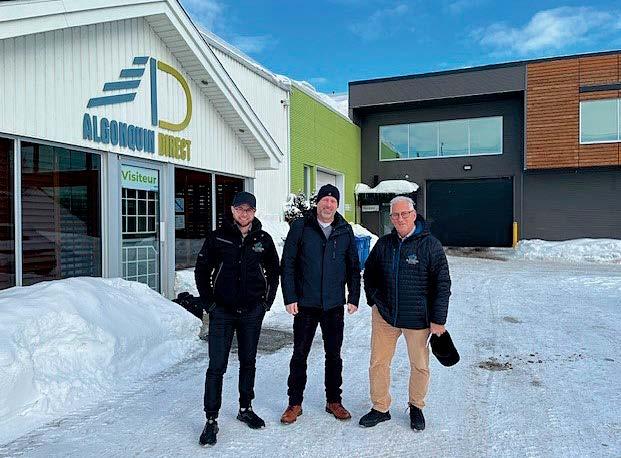
>> Sebastien Grenier, President of Algonquin:
‘‘Our goal with this line is to be at the forefront of the technology in our industry worldwide.”
This System TM solution consists of the following:
• Automated feeding system, Opti-Feed 6000 Vack
• Planer
• MiCROTEC Woodeye Rip scanner
• Rip saw
• MiCROTEC Woodeye Cross-cut scanner
• Optimizing cross-cut saw, Opti-Kap 5103
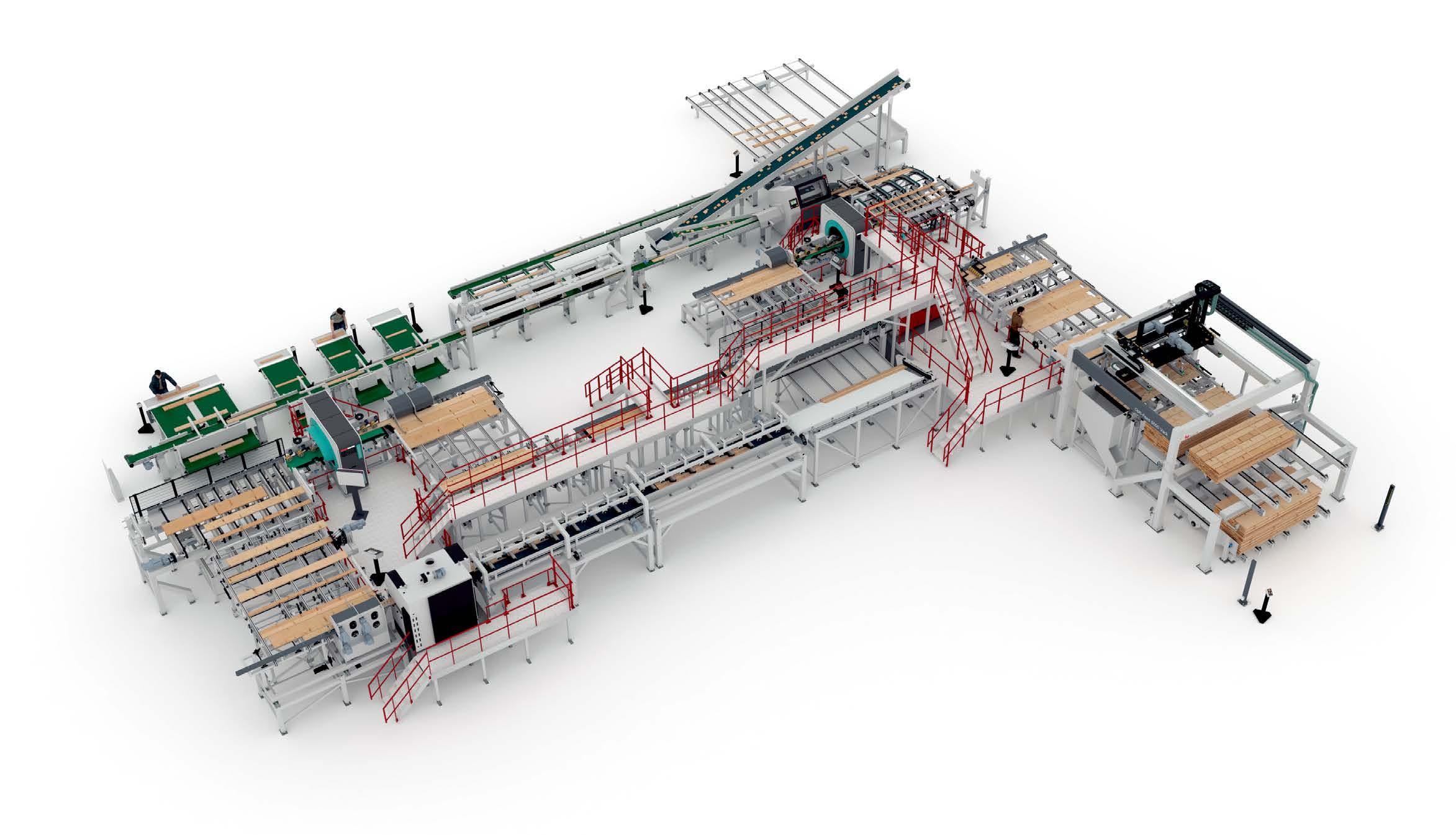
Overview:
Overview:
Production:
Production: Moulding & Millwork
Wood species: Softwood
Number
Number of operators:
7
Algonquin President owner Sebastien Grenier (left) with System TM Area Sales Manager Jean-Luc Croteau (middle) and Algonquin Founder owner Rene Warnet (right).
>>
Windows
& doors
Wood species: Softwood
of
operators:
OPTI-FEED 6000 VACK Automated feeding system PLANER OPTI-KAP 5103 Optimizing cross-cut saw RIP SAW MICROTEC WOODEYE RIP SCANNER Detection of defects and quality before the rip saw MICROTEC WOODEYE CROSS-CUT SCANNER Detection of defects and quality before cross-cutting











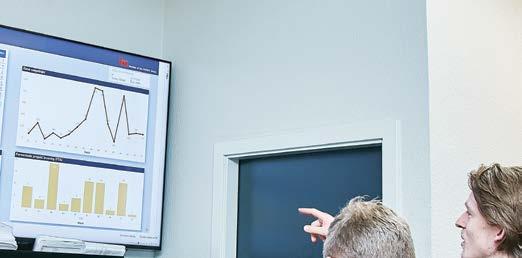


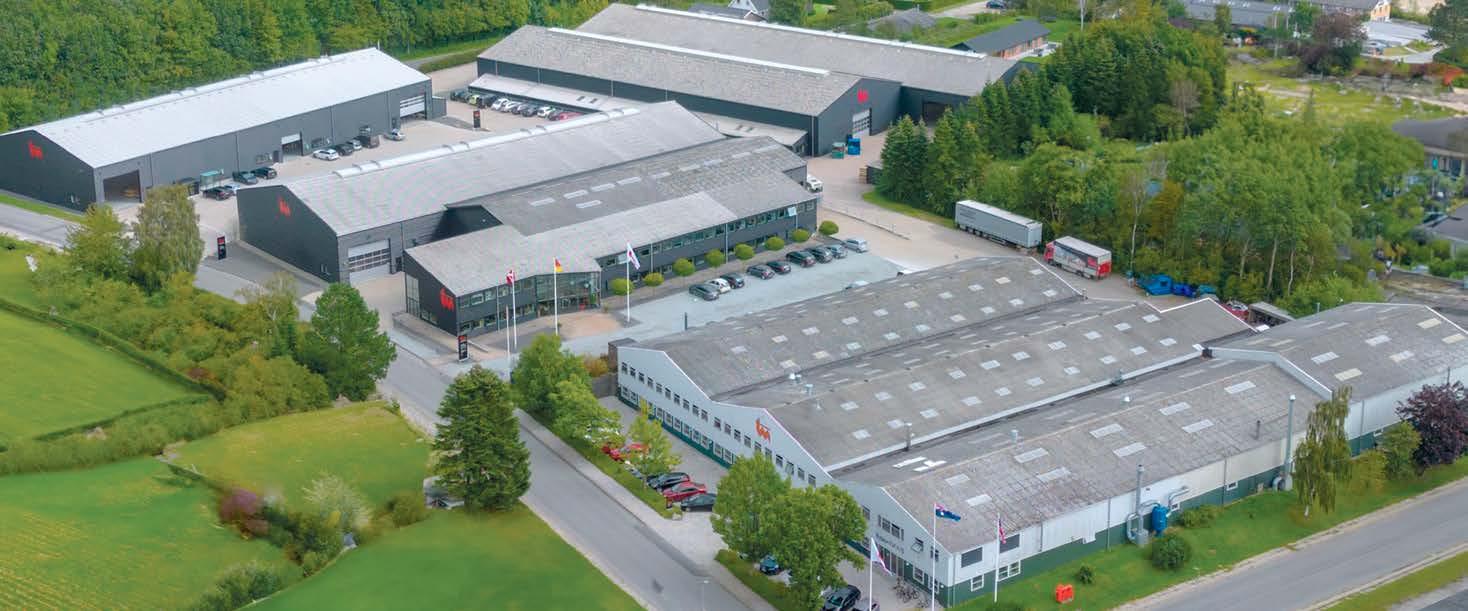
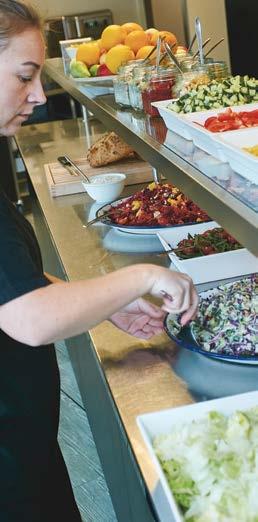






System TM A/S Skovdalsvej 35, DK-8300 Odder, Denmark, Tel:+45 86 54 33 55, tm@systemtm.com, www.systemtm.com no. 1 - 2024 www.systemtm.com Visit System TM at the following exhibitions: IWF, Atlanta , USA ............................................................ August 6 - 9, 2024 Trä & Teknik, Gothenburg, Sweden ................................. September 3 - 6, 2024 Lignum Latin America, Curitiba, Paraná, Brazil ............... September 17 - 19, 2024 LIGNA 2025, Hannover, Germany .................................... May 26 - 30, 2025 Member of the HOMAG Group Meet our dedicated Sales Team Behind the scenes of everyday System TM >> >> E-mail: pj@systemtm.com Mobile: +45 20 12 02 85 E-mail: pjj@systemtm.com Mobile: +45 21 68 38 39 E-mail: ath@systemtm.com Mobile: +45 51 56 61 60 Per Juul Jensen Area Sales Manager Sales area: Australia, New Zealand & Central Europe Allan Them Area Sales Manager Sales area: Scandinavia & Asia Per Jørgensen CSO Sales area: World Peter Simonsen Area Sales Manager Sales area: The United Kingdom, Eastern Europe, France & Spain E-mail: pks@systemtm.com Mobile: +45 21 69 09 31 Jean-Luc Croteau Area Sales Manager Sales area: North America E-mail: jlc@systemtm.com Mobile: +1 581 305 6577 Michael Brandt Area Sales Manager Sales area: North America Rasmus Nissen Baastrup Area Sales Manager Sales area: South America, Japan, Australia & E-mail: mbr@systemtm.com Mobile: +45 41 87 97 79 E-mail: rnb@systemtm.com Mobile: +45 41 87 97 38 Join the conversation! Join the network! System TM Newsletter










 >> Unai Agirre, Managing Director at Egoin Wood Group:
>> Unai Agirre, Managing Director at Egoin Wood Group:
































